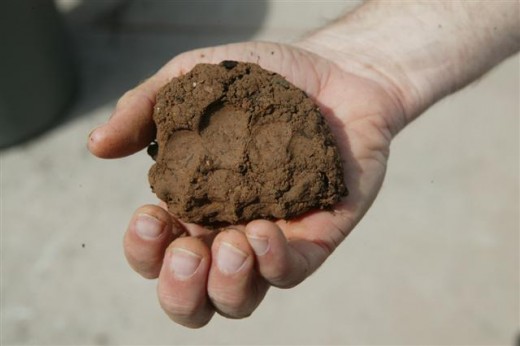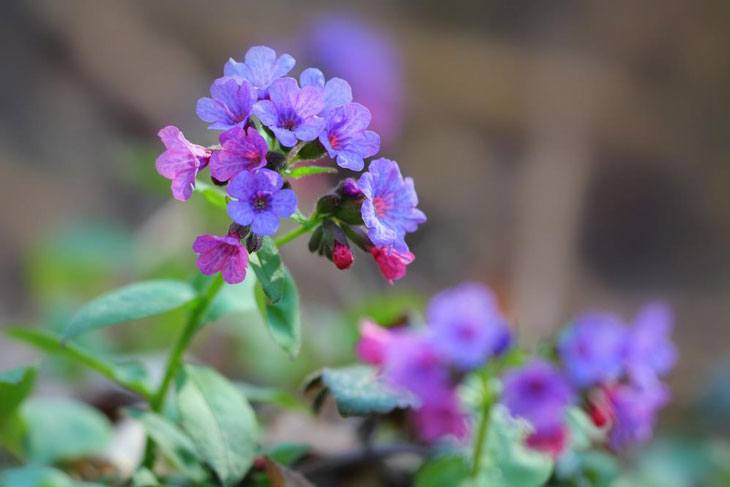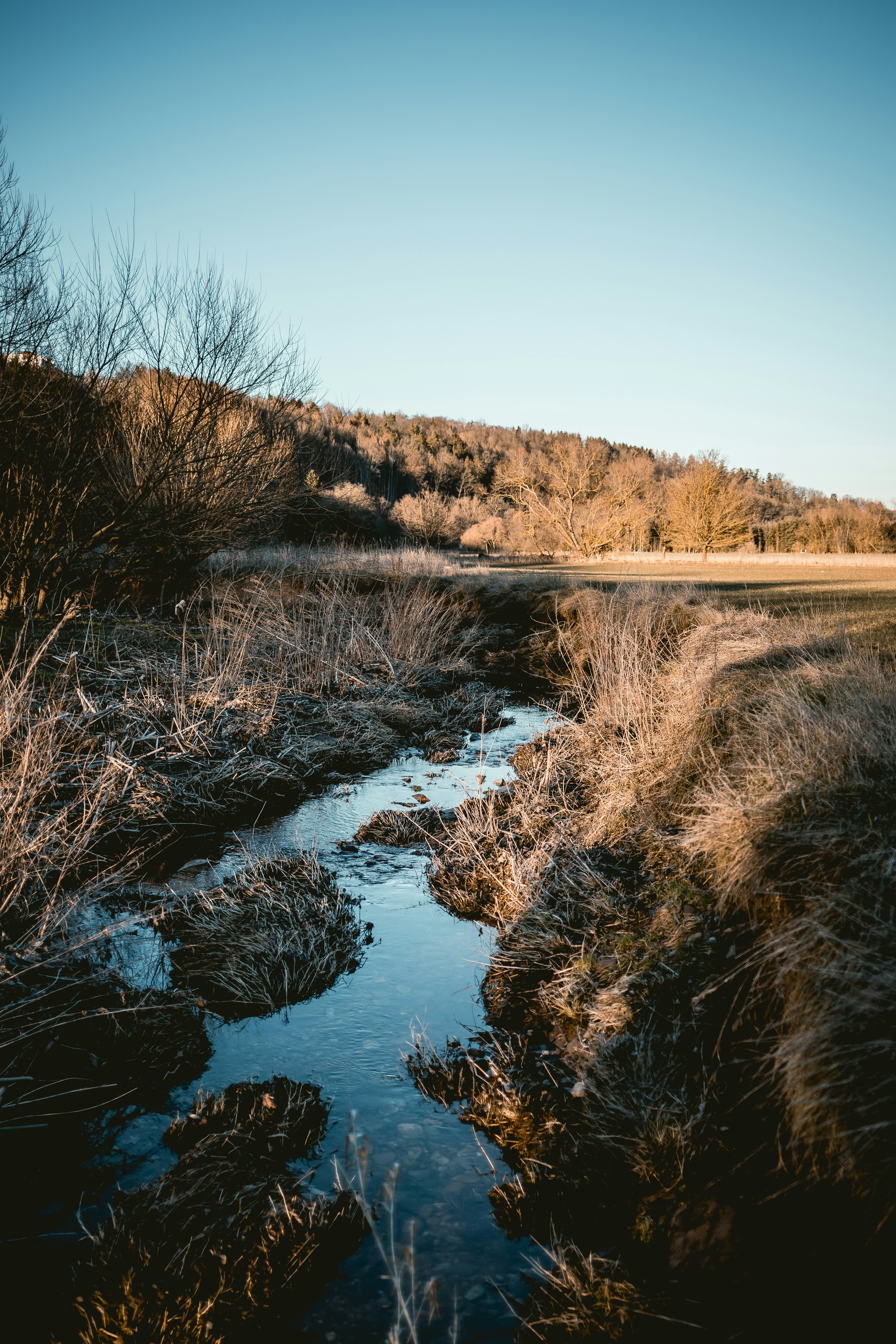The top 8-10 inches of soil, where plants' roots live, determine the success of your gardening efforts. An ideal soil from a plant's perspective is 50% soil matter and 50% open, or pore space (which should be half-filled with water and half left open for air). Clay soil, and soil near recent construction, is often too compact to allow roots to "breath." Adding organic matter to the soil lightens soil structure (also called "tilth"). Soil structure is how the individual clay, silt, and sand particles are arranged, and is impacted by factors such as organic matter. Clay without organic matter is like a flattened deck of playing cards.
Adding organic material jumbles the cards, permitting water and oxygen to enter the soil. Digging will help to improve the drainage of clay soils, but is unnecessary on loam or sandy soils. While you are digging, incorporate as much bulky organic matter as you are able. Alternatively, you can make leafmould from fallen tree and shrub leaves. Organic matter such as manure helps sandy soil to retain moisture and nutrientsOrganic matter is a kind of cure-all in the garden.
Any organic matter will work to build soil structure and its ability to hold onto water. Compost and manure are preferred because they are rich in nutrients, which they drip-feed to your plants. Over time, they'll also help to increase the pH of acidic sandy soils. Soil amendments are materials that are worked into the top several inches of soil, to improve drainage and loosen the soil where plants grow.
Organic soil amendments can make a world of difference in heavy clay soils. Organic matter breaks down fast in our warm climate, so beds will need regular additions of soil amendments to maintain good soil structure and fertility. The best way to improve soil texture is by adding organic material, such as compost or peat moss. Decaying organic matter helps sandy soil by retaining water that would otherwise drain away.
And it corrects clay soil by making it looser, so air, water, and roots all can penetrate. Plus, in all soils it encourages beneficial microbial activity and provides nutritional benefits. At the opposite end of the scale from sandy soil are clay soils. These hold water and nutrients very well but don't drain as well as sandy soils, especially if compacted, a common situation for lawns with a clay soil base.
Well rotted composts and manures will be relatively poor in soluble nutrients but rich in insoluble ones. On most soils they are best incorporated by cultivation in spring just before growth starts. However, autumn application can also work on all but sandy soils. Avoid applying in late summer as the warm soil can lead to significant nutrient loss as the materials will breakdown quickly to produce soluble nutrients easily washed out by winter rains.
On a garden scale it is often feasible to cover vegetable beds with a plastic sheet to shed excess rain and retain valuable nutrients. All organic materials will eventually decompose in soil and therefore must be renewed from time to time, especially in annual flower and vegetable beds that are continually cultivated. Clay soils benefit from organic matter too, because it improves their structure by binding clay particles into crumbs; this allows better air and water movement. By adding coarse sand to heavy soils you can make a permanent improvement in their texture. Spread the sand to a depth of 5–8 cm, then mix well into the topsoil to a depth of 15–20 cm.
Organic dry fertilizers are mixed into the soil according to the directions on the label and then watered. They work more slowly than liquid fertilizers, but last longer. Fertilizer blends contain different amounts of nitrogen, phosphorus and potassium. Other fertilizers may contain bat guano, rock phosphate, molasses or other ingredients.
There are dozens of recipes for making your own organic fertilizer. Next, gently squeeze the ball to lengthen it into a strip or 'ribbon' and see how long you can make it before it starts to break up. The more clay it contains, the longer the ribbon will get and the more plastic it will feel to the touch.
Soil ribbons can range in length from about 5mm – 75mm, with sandy soils being shortest, loamy soils in the middle and clay soils the longest. While soils that contain a lot of clay or sand may need work to improve them, loamy soils are generally ideal. These contain a mixture of sand, silt, organic matter and clay, providing the right balance of nutrients, oxygen, water and drainage which are just what your lawn needs. I always see things on how to work with sandy, silty, or clay soils, practically nothing on peat soils. I moved to an area this last Fall, that had a lot of glacier activity and is a meadow or grass land now. We would like to grow a garden, but we have black peat soil for about 14 feet down.
I used a home soil test and found no nitrogen in the soil. There is some phosphorus and a small amount of potassium. What should we do to our soil to be able to grow a vegetable garden and fruit trees? The disadvantage of heavy clay soil is that it becomes waterlogged, with poor drainage and aeration. Gardeners with a heavy clay soil need to mix in some gypsum - a natural mineral.
This helps to break up the clay and will improve its structure so that it forms crumbs that are easy to work. Add organic matter, such as compost or aged animal manures, because they're important for all soils. When we moved to 'rock hill', I just gave up the first year or two growing in the ground and started my new garden in tubs and buckets. As those gardens produced I was working in starting new beds and building them up as organic materials became available as we worked the new territory. 🙂 Clearing brush allowed for some big hugelkulture beds that are now starting to produce in years 3 & 4 here. Clearing some overgrowth and raising the canopy gave us sunlight – that lil' essential most plants needs.
Clearing some of the brush allowed us to pile it in hedgerows that prevent erosion and give wildlife a place to live. We are following that old saw "Inch by inch life's a cinch, yard by yard, life is hard." We are eating this elephant one bite at a time, one season at a time, one project at a time. Not having a bunch of money to throw at the problem all at once we grow incrementally. Fruit tree layer first, then we had a shrub planting year, then a perennial plant year, etc.
Cover crops – If you do not choose manure for livestock, the cover crops are an alternative solution. The cover crops, also known as green manure, consist of plants plowed under and mulched back onto the soil to boost their productivity. Green manure is a sustainable farming activity accessible to gardeners.
Grasses of fast-growing grains are a strong option in early spring as cover crops. Cold-hard legumes, such as peas, can start in late winter and develop for two months or longer to precede a heavy-food crop such as winter squash. You can use them as cover crops to fertilize garden beds and soils.
Good soil provides just the right space between its particles to hold air that plants will use. Silty and heavy clay soils have small particles that are close together. Sandy soils have the opposite problem; their particles are too big and spaced out. The excessive amount of air in sandy soil leads to rapid decomposition of organic matter. Organic soil is rich in humus, the end result of decaying materials such as leaves, grass clippings and compost.
Good organic garden soil is loose and fluffy — filled with air that plant roots need — and it has plenty of minerals essential for vigorous plant growth. It is alive with living organisms — from earthworms to fungi and bacteria — that help maintain the quality of the soil. Proper pH is also an essential characteristic of healthy soil.
To feed the soil, and improve its structure, use bulky materials like garden compost compost, rotted manures or leaf mould. These materials release nutrients slowly, improve soil conditions, and stimulate essential micro organisms. Growing green manures is another organic technique for soil improvement. Liquid feeds can help your plants in times of stress, mycorrhizal fungi improve root nutrition uptake and worms will sort out your soil. Finally, you may like to try the No Dig method - which uses thick mulches to suppress weeds. Clay's potential as one of the best soil types for plant growth lies in its unique properties.
Managed well, clay soil typically requires less irrigation and less fertilizer, and leads to healthier plants all around. Chop over-wintered cover crops directly into spring soils a few weeks before planting. During the growing season, sow a quick-growing cover crop, such as buckwheat, to fill the gap between spring and fall crops.
When it's time to plant, pull the buckwheat cover and use it as a mulch for fall garden beds. Cover crops are a temporary planting, usually sown in the fall, that help protect the soil from wind and erosion and add valuable organic material. They also establish a dense root structure that can have a positive effect on soil texture. Cover crops also suppress weeds, deter insects and disease and help fix nitrogen.
When the crops are turned into the soil, they become green manure . Many farmers across sub-Saharan Africa try to coax crops out of sandy soils that are not ideal for holding water and nutrients. A traditional approach would have them apply more fertilizers and use irrigation, but both of these options require access to resources and infrastructure that many of them do not have. The way to improve this type of soil is to add bulky organic matter in spring.
Use plenty of farmyard manure, garden compost or organic soil conditioner when planting to give moisture-holding material at the root level. Mulch all over in late spring to reduce evaporation and use ground cover plants to shield the soil. This heavy, often dark, smooth soil is made up of very fine particles between which there are small air spaces. It is difficult to cultivate, being sticky when wet, yet hard and even cracking, when dry. In situations where drainage is poor, plants can rot because of waterlogging and a lack of air around the roots. Clay is also a cold soil taking time to warm up in spring, which can slow a plant's root growth.
On the upside, clay is not only richer in nutrients than sand, but also retains nutrients and holds water well. As I explained in the previous article, when you first start gardening, it may be necessary to use rock powders, and other slow-release sources of minerals, to correct mineral deficiencies in the soil. In the long run, however, you can supply minerals without purchasing inputs. The organic materials we add to our soil supply most of the minerals healthy crops need. In addition, we plant "fertility patches" to grow a lot of our own mineral supplements.
Adding organic matter in the form of compost and aged manure, or using mulch or growing cover crops , is the best way to prepare soil for planting. Adding chemical fertilizers will replenish only certain nutrients and do nothing for maintaining good, friable soil. Organic matter will help supply everything your plants need. Following any of these treatments applying 6X in early spring gets your garden off to the perfect start for the season. 6X is a well-known and well-loved alternative to traditional farmyard manure which takes a lot of the effort out of spreading manure on the garden.
One 15kg sack is equivalent to six or more sacks of traditional bagged farmyard manure and treats up to 184 sq metres . The two soil extremes are heavy clay and light, sandy soils – both can be improved by adding lots of bulky organic matter to improve the structure and widen the range of plants that will thrive. Legumes are especially valuable cover crops, because they fix nitrogen from the atmosphere into forms available to crop plants. You can increase the amount of organic matter in your soil by adding compost, aged animal manures, green manures , mulches or peat moss. Because most soil life and plant roots are located in the top 6 inches of soil, concentrate on this upper layer.
To learn more about making your own compost, read All About Composting. Before planting every year, ensure sufficient nitrogen by counting all the sources you've added. Organic fertilizers, such as blood, seed, or feather meal, are sources of concentrated nitrogen.
Fall or spring legume cover crops transfer nitrogen from the atmosphere to the soil. Manures or green grass clippings, incorporated as amendments, provide nitrogen as well. Compost, on the other hand, does not supply enough garden nitrogen. While compost is great for improving overall soil health, additional nitrogen sources are needed when using compost as an amendment.
Chop organic material directly into the top 2 inches of soil with a heavy bladed hoe and cover with mulch. Ideally, add concentrated manures, mineral phosphorous and potassium fertilizers, and lime at the same time. Adding these materials in the fall gives them time to break down for use when plants need them in the spring. Sandy Soil – This type of soil is usually formed as rocks like granite, limestone, and/or quartz fragment and breakdown.
Sandy soils are poor soil types for growing plants because it has little to no nutrients and poor water holding capacity, which makes it hard for plant roots to absorb water and establish themselves. Alkaline soil on the other hand, needs to be made more acidic. This can be done with the addition of sulfur, sawdust, conifer needles, sawdust or oak leaves. Heavy clay soils are quite dense, do not drain well and tend to be hard and crack when dry. Because there isn't much space between the clay particles, there usually isn't much organic matter or microbial life in the soil.
Plant roots have a hard time growing in the hard material. Clay consists of minute mineral particles that tend to cling tightly together. Because there are lots of them they have a big surface area which efficiently hangs on to water and nutrients. Soils with larger particles have more air space and allow the passage of water more freely.


























No comments:
Post a Comment
Note: Only a member of this blog may post a comment.